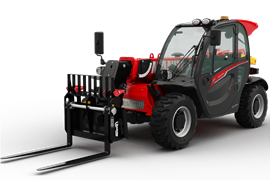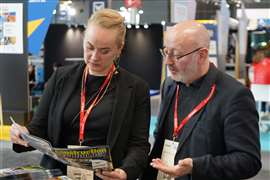NFPA macroeconomic forecast offers insights for manufacturing
15 September 2024
While the presentation Alan Beaulieu of ITR Economics delivered to the National Fluid Power Association’s (NFPA) 2024 Industry & Economic Outlook Conference (IEOC) focused on the fluid power business, there was much he said that could be applied to manufacturing more broadly. Many of his insights signaled a positive future.
“We’re going to do macro,” said Beaulieu, consulting principal for ITR, “and we’re going to touch on why you’re going to be happier as we go forward. You will find that it’s not easy, but you’ll be happier.”
U.S. GDP Ascending
Part of the positive outlook has to do with worldwide gross domestic product (GDP). According to Beaulieu, the United States’ makes a 26.1 percent contribution to the worldwide GDP of US$104.7 trillion — the largest of any country. That bodes well for U.S. business prospects.
“You know what’s neat about that number?” he said. “It’s larger than it was the year before. The U.S. is growing in share.”
 Image: Love Employee via Adobe Stock
Image: Love Employee via Adobe Stock
Addressing some reports that China was in fact on track to become the largest economy in the world, Beaulieu said China’s GDP contribution stood at 16.9 percent. In a distant third was Germany at 4.3 percent, despite it being the biggest economy in the European Union (EU).
“The United States is on the ascent,” he said. “The United States is the go-to nation.” Additionally, Beaulieu added that forecasts of a forthcoming “Great Depression” — which is expected around 2030 and which Beaulieu and his brother addressed in their book, “Prosperity in the Age of Decline” — will only strengthen the U.S.’ position.
“If you’re worried about what the future’s going to be like for your kids, it’s going to be better than it is now,” he said. “If you’re wondering what it will be like for your grandchildren, which would be the age I would worry about, they’re going to have a North America that’s more vibrant than it is today, because China is on the way down.”
Beaulieu added, “China has had demographic issues, and they’re just going to continue to feel pain, because when you don’t have a population that’s growing, you have an economy that’s shrinking.”
In 2022, the Pew Research Center cited United Nations projections that China would lose the title of most populous nation — which it had held since about 1950 — to India in 2023. U.N. World Population Prospects data for 2024 seems to bear that out, with China having a population of 1.422 billion in 2023 and India having 1.438 billion. At present, the data reveals the gap between the countries has widened this year to a difference of 31.6 million in India’s favor.
Industrial Production and Nationalism
Beaulieu revealed a graph showing that while the world industrial production index through this year into 2025 remains relatively flat, it is expected to grow about 1.3 percent in 2026.
“Exports are increasing in this country, and exports make up around 10 percent of GDP,” he said. “And as exports increase on the world economy, you’re going to find yourself doing better because of historical relationships, as you will. Because as exports go, industrial production goes. It adds to industrial production in this country, and it adds to your upward movement.”
Beaulieu also touched on rising nationalism in the United States, saying it will result in shorter supply chains and new business opportunities.
“The more dangerous the world becomes — and it is becoming more dangerous — the more you’re going to see nationalism occur,” he said, adding that it may result in business returning from China to North America. “What you want to look for as you go forward, then, are those opportunities that reshoring will bring, nationalism will bring, and that the future holds for you.”
Rising Input Costs
As Beaulieu mentioned, capitalizing on this positive news will not be easy; there will be hurdles to overcome. For example, inflation and its effects will continue to deliver headwinds.
With the U.S. Consumer Price Index (CPI) showing inflation at 3.3 percent, Beaulieu said disinflation is occurring, but not at a rate fast enough to encourage action from the Federal Reserve Board.
 Image: jirsak via Adobe Stock
Image: jirsak via Adobe Stock
“It’s not happening fast enough for the Fed to be able to say, ‘Let’s cut interest rates by 50 basis points, and then we’re going to cut them again,’” he said. “If you’re waiting for that, you’re waiting for something that’s not going to happen.”
Pivoting to the U.S. Producer Price Index (PPI), which represents manufacturing input costs, Beaulieu noted the rate of change is beginning to climb.
“We’re going to see that going up a little bit, being kind of flat in 2025 and going up in 2026,” he said. “But what I’m telling you is your input costs through 2025 will be higher than they were in ’24. So, as you listen to the media talk about disinflation and pricing and all the rest of that, remember — that’s not your world.”
Beaulieu added that costs would likely continue to climb through the end of the decade.
“When we look at the fluid power machinery and equipment PPI compared to the overall PPI, you can see a nice, strong correlation,” Beaulieu said. “So, the overall PPI is going up, and you’re going to find soon that your PPI, the total power machinery and equipment producer price index, will be going up, as well, and be going up for the rest of the decade.”
Electricity Costs Climbing
Of the various input costs that will be rising, two are of particular interest: electricity and labor.
Beaulieu cited several trends driving increased electricity costs. These include the rise of artificial intelligence (AI), the proliferation of data centers and cryptocurrencies. According to Beaulieu, the end of 2026 will see additional electric power consumption that could be as high as that currently consumed by all of Germany.
Another factor is the rise of electric vehicles (EV).
“When we look at everything that is going to be going on, then, for electricity generation, ask yourself: can we generate enough electricity in this country?” Beaulieu said, adding the new power plants take time to bring online.
“The number one source of energy for electricity generation is natural gas,” he said. “We have plenty of that, but we need facilities to convert natural gas to electricity.”
Beaulieu added, “Getting electricity to your door is in horrible condition in this country. So, we have an infrastructure that can’t handle today’s load. How are we going to handle this load? And that’s a weakness in our economy.”
Labor Market Challenges
Median annual wages and a tight labor market will continue to be hurdles through the end of the decade. AI will also going to have an impact on the labor market, but not in a positive way for manufacturing.
“AI is not going to ease the labor market the way that some people expect,” Beaulieu said. “AI is not going to turn out mechanics, HVAC technicians or any of that.”
He added, “I don’t want you to think for a minute that it is an answer. We simply do not have enough people in this country for the economic growth and for the jobs that are being created. And from now through the rest of the decade, you can expect that your labor costs are going to go up about 28 percent.”
Addressing Rising Costs
Noting that interest rates will also be rising continually through the end of the decade, Beaulieu offered a solution to address escalating input costs.
“If interest rates are going to be going up through the rest of this decade, what must you do now? Borrow,” he said, adding that companies need to borrow to make their businesses more efficient. “You’re going to want to take your business and make sure that you’re dealing in a way that you can get ahead of the PPI costs, the labor costs, the electricity costs. You’re going to make yourself so efficient that you can remain very profitable, even as the costs are going up.”
Beaulieu said that the right messaging coupled with the right cost structure can allow businesses to remain profitable in the face of inflationary pressures.
“If you don’t have either of those, inflationary pressures are going to erode your EBITDA, and you’re going to try to survive through the rest of this decade,” he said. “As it erodes your EBITDA, you could find obviously that it is more difficult to continue on, because on the way up in an expanding business cycle, it takes more cash. And as you need more and more cash, if this cost structure is eating away at that cash, fixing it is more difficult.”







